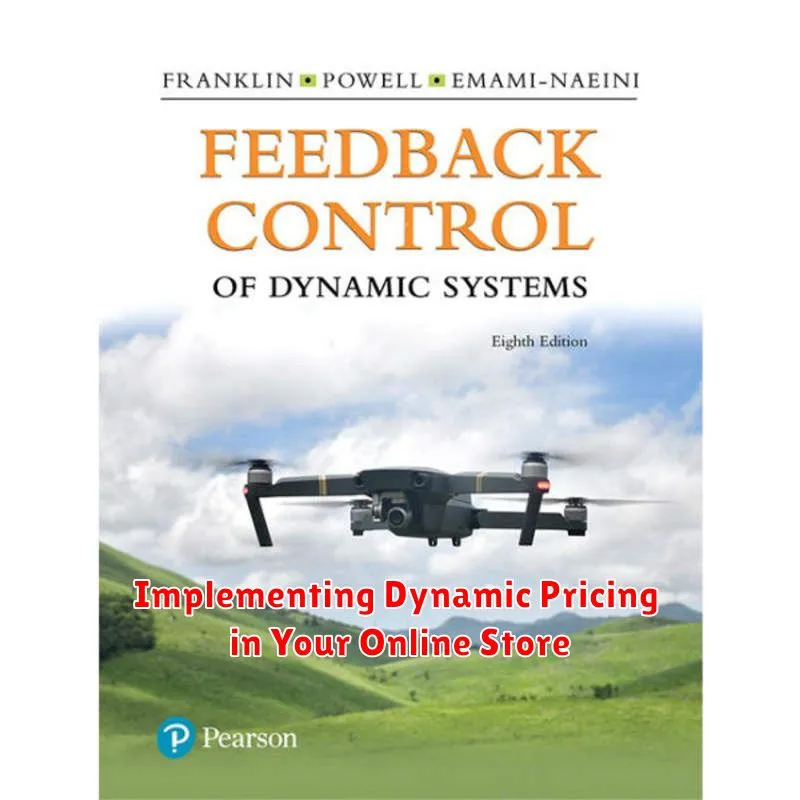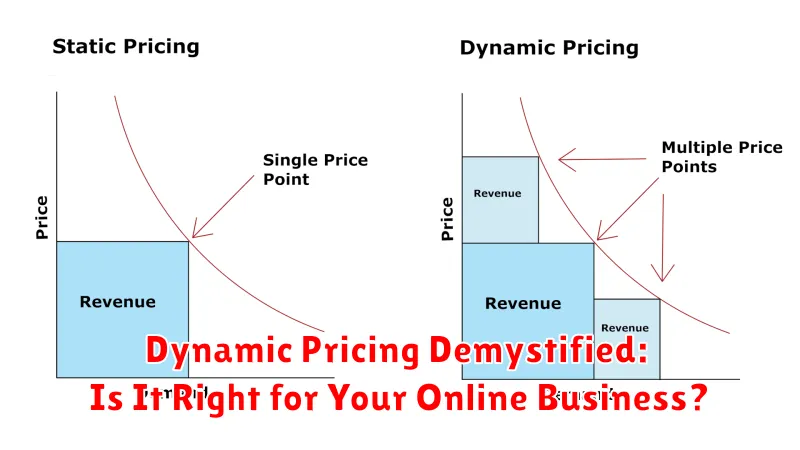In today’s ever-evolving e-commerce landscape, dynamic pricing has emerged as a powerful tool for online businesses seeking to optimize revenue and stay competitive. Dynamic pricing, also known as surge pricing, time-based pricing, or demand pricing, involves adjusting prices in real-time based on a variety of factors, including market demand, competitor pricing, and inventory levels. This sophisticated approach allows businesses to maximize profits by capturing the highest possible price consumers are willing to pay at any given moment. But is dynamic pricing right for your online business? This article will demystify the complexities of dynamic pricing, exploring its benefits, drawbacks, and crucial considerations for implementation.
Understanding the nuances of dynamic pricing is paramount for any online business considering its adoption. While the potential for increased revenue is undeniable, implementing dynamic pricing requires careful planning and execution. This article will delve into the mechanics of dynamic pricing strategies, examining different models and the factors influencing price fluctuations. Furthermore, we will explore the ethical implications of dynamic pricing and offer practical guidance to help you determine if this powerful pricing strategy aligns with your business objectives and target audience. By the end of this article, you will possess a comprehensive understanding of dynamic pricing and be equipped to make informed decisions about its potential role in your online business.
What is Dynamic Pricing?
Dynamic pricing, also known as surge pricing, time-based pricing, or demand pricing, is a pricing strategy where businesses set variable prices for products or services based on market demands at a particular moment. Instead of having a fixed price, prices fluctuate based on a variety of factors.
This sophisticated approach utilizes algorithms to analyze data and adjust pricing in real-time. Factors influencing these price changes commonly include competitor pricing, levels of supply and demand, customer behavior patterns, and external factors like seasonality or special events.
Essentially, dynamic pricing allows businesses to maximize revenue by charging higher prices when demand is high and offering lower prices during periods of low demand to stimulate sales.
How Does Dynamic Pricing Work?
Dynamic pricing relies on sophisticated algorithms that analyze a multitude of data points to determine the optimal price at any given moment. These algorithms consider factors such as real-time demand, competitor pricing, inventory levels, and even seasonality.
The process begins with setting a base price. This serves as a foundation upon which the algorithm makes adjustments. Then, the algorithm continuously monitors the pre-determined factors and adjusts the price accordingly. For example, if demand for a product suddenly surges, the algorithm might increase the price to capitalize on the heightened interest. Conversely, if demand is low, the price might be lowered to stimulate sales.
The frequency of price changes can vary significantly depending on the business and the specific implementation. Some businesses might adjust prices multiple times per day, while others might only make adjustments weekly or monthly. The algorithms are typically designed to operate within pre-defined price ranges to prevent extreme fluctuations that could alienate customers.
Benefits of Dynamic Pricing
Dynamic pricing, when implemented effectively, offers several key advantages for online businesses.
Increased Revenue and Profitability: By adjusting prices in real-time to reflect demand and market conditions, businesses can optimize revenue potential. Higher prices during peak demand capture additional value, while lower prices during slower periods can stimulate sales and prevent lost revenue.
Improved Competitiveness: Dynamic pricing enables businesses to quickly react to competitor price changes, maintaining a competitive edge in a fast-paced online marketplace.
Better Inventory Management: Dynamic pricing can help balance supply and demand. Lowering prices on overstocked items encourages sales and reduces inventory holding costs.
Enhanced Customer Segmentation: Different customer segments have varying price sensitivities. Dynamic pricing allows businesses to tailor pricing strategies to different customer groups, maximizing overall revenue and customer satisfaction.
Drawbacks of Dynamic Pricing
While dynamic pricing offers several advantages, it’s crucial to acknowledge its potential downsides. A primary concern is the risk of alienating customers. Frequent price fluctuations can erode customer trust and loyalty, particularly if perceived as unfair or manipulative. Price volatility can lead to a negative brand image, especially if competitors offer more stable pricing.
Complexity is another significant drawback. Implementing and managing a dynamic pricing strategy requires sophisticated software and analytical capabilities. Monitoring market trends, competitor pricing, and internal costs necessitates substantial resources and expertise. Moreover, incorrectly configured algorithms can lead to pricing errors, potentially resulting in lost revenue or reputational damage.
The potential for a price war is another concern. If competitors also employ dynamic pricing, it can lead to a race to the bottom, driving down profit margins for all involved. This competitive pressure can create instability in the market and make it difficult to maintain consistent pricing strategies.
Finally, ethical considerations must be taken into account. Dynamic pricing can raise concerns about price discrimination and fairness, especially if vulnerable customer segments are charged higher prices based on their perceived willingness to pay. Transparency is key to mitigating these concerns, but finding the right balance between providing clear pricing information and protecting proprietary algorithms can be challenging.
Examples of Dynamic Pricing in Action
Let’s illustrate dynamic pricing with a few practical examples across different sectors:
Ride-Sharing Services
Companies like Uber and Lyft utilize dynamic pricing, often referred to as “surge pricing.” During periods of high demand, such as rush hour or special events, prices automatically increase. This incentivizes more drivers to become available, helping to meet the increased demand.
E-commerce Retailers
Online retailers frequently adjust prices based on factors like competitor pricing, inventory levels, and even time of day. A popular item with limited stock may see a price increase, while a slow-moving item might be discounted to encourage sales. This allows businesses to optimize revenue and inventory management.
Hospitality Industry
Hotels and airlines commonly employ dynamic pricing. Room rates and airfares fluctuate based on factors like seasonality, occupancy rates, and upcoming events. Prices tend to be higher during peak tourist seasons and lower during off-peak periods.
When to Use Dynamic Pricing (and When Not To)
Dynamic pricing can be a powerful tool, but it’s not universally applicable. Understanding the optimal scenarios for its use is crucial for maximizing benefits and minimizing risks.
When to Use Dynamic Pricing:
Consider dynamic pricing when you have:
- Perishable goods or limited-time offers: Think airline tickets, concert seats, or hotel rooms. Dynamic pricing can optimize revenue based on demand fluctuations.
- High demand variability: If your product experiences significant shifts in demand due to seasonality, competitor actions, or other factors, dynamic pricing can help capture optimal value.
- Large product catalogs: Managing prices manually across a vast inventory can be overwhelming. Dynamic pricing automates this process, responding to market signals in real-time.
- Clear pricing goals and data-driven insights: If you have well-defined revenue or market share goals, and the data to track them, dynamic pricing can help you achieve those objectives.
When Not to Use Dynamic Pricing:
Avoid dynamic pricing if:
- Building brand loyalty is paramount: Frequent price changes can erode customer trust and create a perception of unfairness, especially for essential goods.
- Operating in a highly price-sensitive market: Dynamic pricing can trigger a price war if competitors react aggressively.
- Lacking sufficient data or technical resources: Effective dynamic pricing requires robust data analysis and implementation capabilities.
Implementing Dynamic Pricing in Your Online Store

Implementing dynamic pricing involves integrating software or tools with your existing e-commerce platform. Choosing the right solution is crucial for seamless implementation and effective price adjustments.
Several options exist for implementing dynamic pricing:
- Dedicated Pricing Software: These specialized platforms offer advanced pricing algorithms, competitor monitoring, and analytics. They often integrate directly with popular e-commerce platforms.
- E-commerce Platform Extensions/Plugins: Many e-commerce platforms offer built-in dynamic pricing functionality or extensions that can be easily installed.
- Custom Development: For businesses with highly specific pricing needs, custom-built solutions offer the most flexibility and control.
Regardless of the chosen method, ensure your chosen solution can handle your product catalog size, sales volume, and desired pricing strategies. Proper data integration between your inventory management system, sales data, and the pricing software is essential for accurate and effective dynamic pricing.
Once implemented, thorough testing is critical. Start with a small group of products or a limited segment of customers to monitor the impact on sales and profits before a full-scale rollout. This allows you to refine your pricing rules and avoid potential negative consequences.
Best Practices for Dynamic Pricing

Transparency is paramount. While you don’t need to disclose your exact pricing algorithm, be upfront about using dynamic pricing. Explain that prices may fluctuate based on factors like demand and availability. This builds trust with your customers and avoids accusations of price gouging.
Set clear pricing boundaries. Establish minimum and maximum prices to prevent extreme fluctuations that could damage your brand image. This provides a safety net and ensures your dynamic pricing strategy remains within reasonable limits.
Continuously monitor and analyze results. Track key metrics like sales volume, conversion rates, and profit margins to assess the effectiveness of your dynamic pricing strategy. Regularly review and adjust your approach based on the data.
Segment your audience. Different customer segments may respond differently to dynamic pricing. Consider tailoring your strategy based on factors like demographics, purchase history, and loyalty status.
Consider the competitive landscape. Stay informed about your competitors’ pricing strategies and adjust your own approach accordingly. Don’t solely focus on automated adjustments; incorporate market insights into your decisions.

